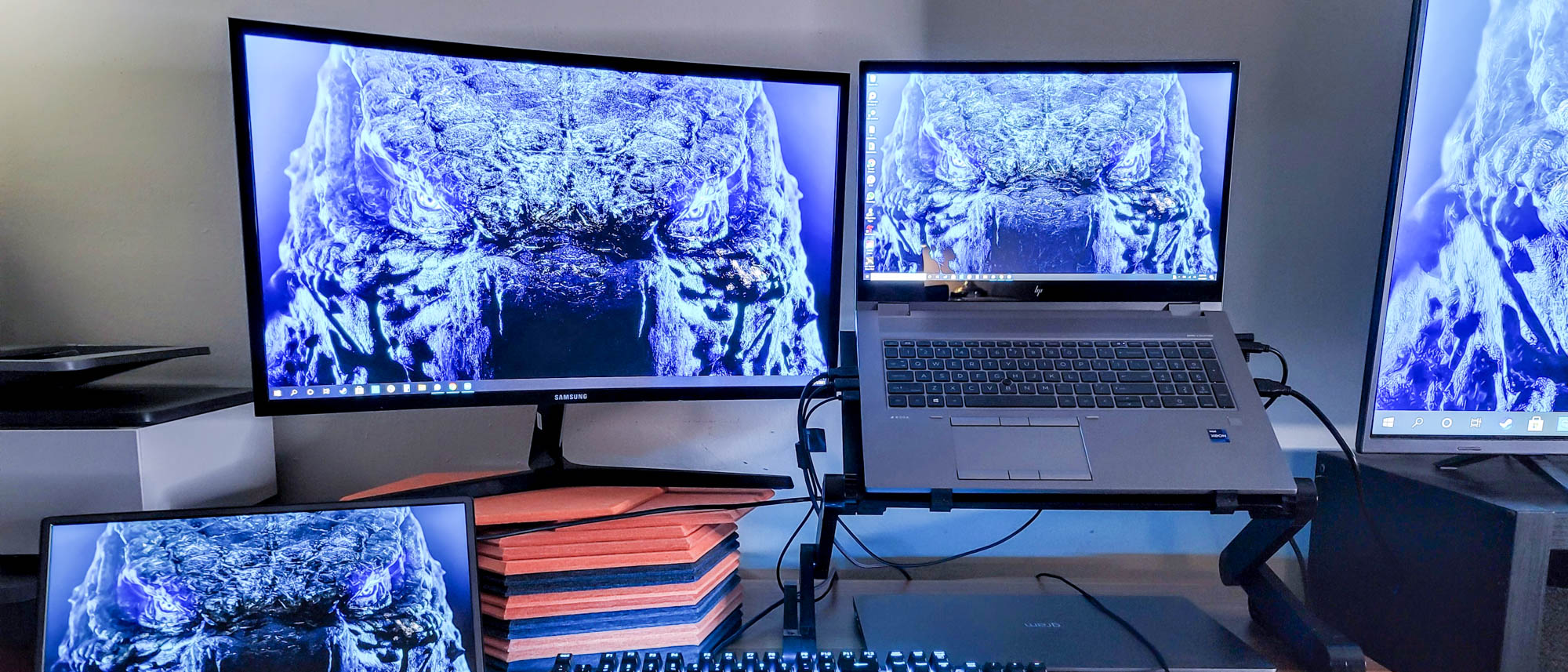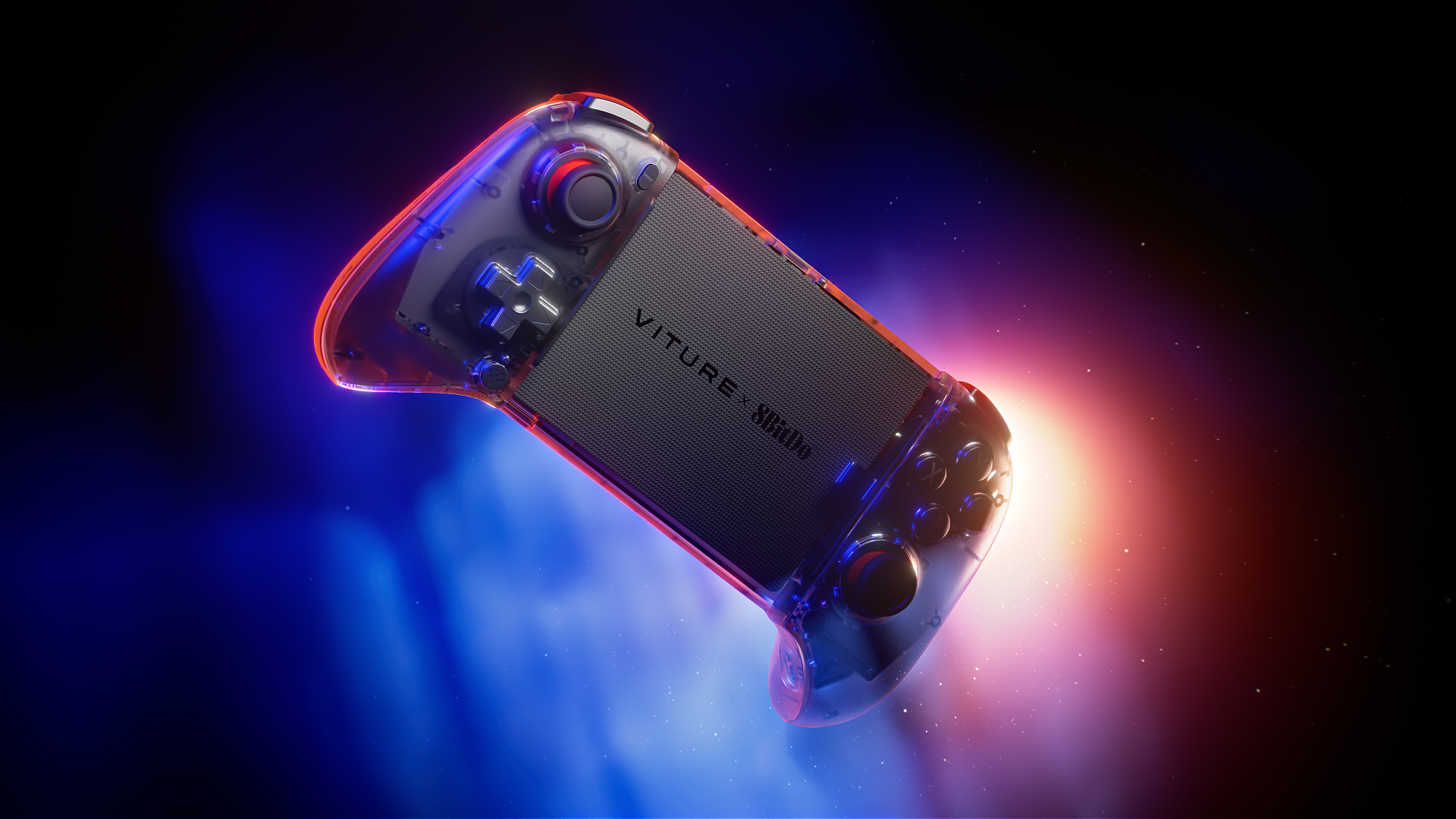Laptop Mag Verdict
Don’t let the unassuming aesthetics fool you. In the known universe of world-class workstations, the HP ZBook Fury 17 G8 laptop may as well be the finger of God.
Pros
- +
Gorgeous 17-inch, 4K touchscreen
- +
Mind-boggling CPU/GPU performance
- +
Integrated fingerprint reader
- +
Minimal bloatware
Cons
- -
Hum-drum design
- -
Prohibitively expensive
- -
Extremely heavy (for a laptop)
- -
Relatively short battery life
- -
Runs noisy and hot when stressed
Why you can trust Laptop Mag
As if you needed another reminder that we live in the future, meet the monstrous HP ZBook Fury 17 G8, a workstation laptop that simply doesn’t know the meaning of “overkill.” It may as well be the mighty megaladon of this laptop category, and if you pry open its mighty maws, you’ll find more memory than most of us know how to meddle with. But with great power comes increasingly irresponsible price points, and you might need to sell off some Bitcoin to afford this kind of “oomph.” While the HP ZBook Fury 17 G8 starts at relatively reasonable $2,118, our review unit was specced out the max, boosting the overall cost to a jaw-dropping $6,421. Holy cannoli on stromboli.
Representing eight generations of progress in HP’s dynamic ZBook lineup, the Fury 17 G8 belongs to a synergistic family of 14- to 17-inch notebooks. Whereas the ZBook Studio and ZBook Firefly are designed to strike a pleasing balance between performance and mobility, the Fury 17 G8 doesn’t give a flying fig about bulk. It’s not called the ZBook Munchkin, after all.
As one might expect from the Metatron of mobile workstations, there are tradeoffs for this magnitude of muscle. Clocking in at a flat 7 pounds, this clunky beast wasn’t exactly designed for on-the-move jetsetters, especially since you’ll only get about 7 hours of battery life on a full charge, at most. That being said, if you plan on plunking the Fury 17 G8 down on a desk and just leaving it in place most of the time, there’s plenty to like about its best-in-class trackpad, keyboard, Bang & Olufsen speakers, and raw, unbridled horsepower. It's easily one of the best workstations, best 4K laptops and best video editing laptops around.
- Still looking for the best workstation? We’ve got you covered, no matter your budget
- The best video editing laptops are often on par with the best cheap gaming laptops
- Check out the HP ZBook Fury 17 G8’s nearest competitor: the MSI WS66 10TMT
Is the HP ZBook Fury 17 G8 the best workstation on the market? I suppose that depends on your budget and configuration, but if your pockets are deep enough for an Intel Xeon processor and Nvidia RTX A5000 graphics (boy howdy!), this is about as future-proof as laptops get right now. If you're looking to do some professional work with VR, this easily is one of the best VR-ready laptops around.
- Give your cheap laptop a bombastic boost with the best eGPUs
- The best laptops can pretty much do it all
HP ZBook Fury 17 G8 mobile workstation: Price and configuration options
When I priced out my G8 unit on HP’s website, I felt something dislocate in my lower jaw. The cost of entry is no joke, folks: $2,118 for the base model, which includes an Intel Core i5-11500H CPU (overclockable to 4.6 GHz), Intel UHD Graphics, a 1920 x 1080 display, 16GB of RAM, and a 256GB SSD.
But let’s assume you’ve already “borrowed” your boss’ black Amex earlier today, and it’s burning a hole in your pocket, bigtime. Such seemed the scenario for my review unit, which was only missing a God Mode button somewhere on the keyboard. It came fully loaded with an Intel Xeon W-11955M CPU (+$1,239), discrete Nvidia RTX A5000 graphics (+$3,147), a 3840 x 2160 LED touchscreen display (+$483), 64GB of RAM (+$820), a 1TB SSD (+$365), and a few other bells and whistles, jacking the price all the way up to $6,421 total.
Granted, you don't have to shoot for the moon as you’re speccing out your config; there are ten different Intel Core i5, i7, and i9 processors to choose from, not to mention six different Nvidia cards. You can also load this bad boy up with anywhere from 8GB to 128GB of RAM, which would have sounded insane just a few years ago. Speaking of insane, the chassis somehow has room for four hard drives, which means you can cram up to 8TB of space in there should your gold-plated heart desire. Eight damn terabytes of storage inside a singular laptop? I feel like I’m taking crazy pills!
HP ZBook Fury 17 G8 mobile workstation: Design
When you’ve got this much power under the hood, functionality is going to win over aesthetics every time. And rest assured, you’re going to notice the ZBook 17 G8 in your backpack. Or on your desktop. Or anywhere you put it, really; this thing is friggin’ massive. But given its purpose, that’s not necessarily a bad thing. (I’d recommend picking up a protective laptop case for additional protection, though.)
So let’s embrace the bulk. Besides, what lies below necessitates a bulky build, which is hardly displeasing to the eye. Decked out in a sleek gunmetal gray, the lid is adored with a giant Z logo, and...well, nothing else. I appreciate the simplicity here. The chassis is built from anodized aluminum and magnesium, and HP says up to 49.7% of all their product metals are recycled; their packaging material is made from recycled materials, too.
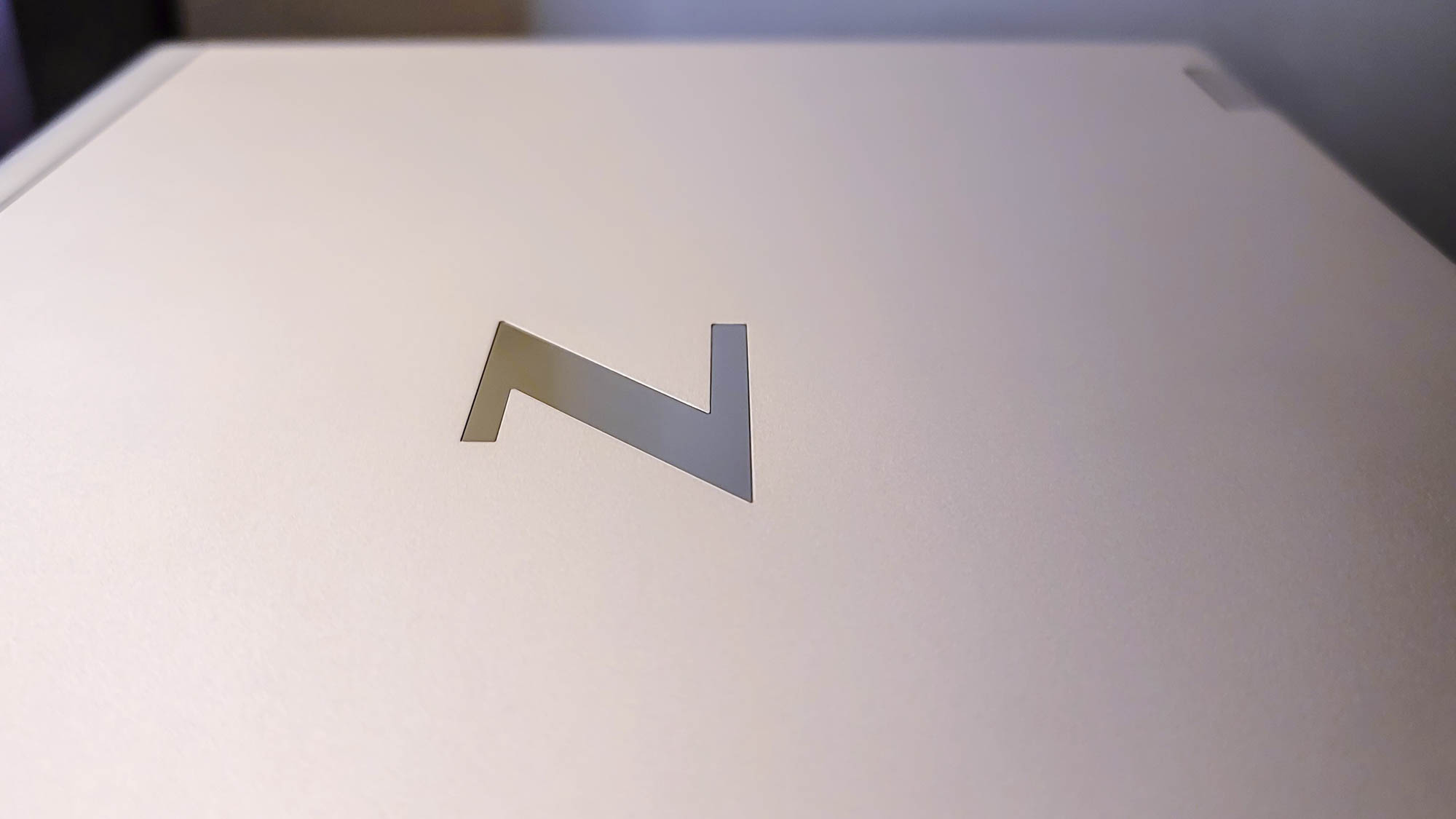
Pop open the lid, and you’ll find dual stereo Bang & Olufsen speakers above the full-size backlit keyboard, which has a full numeric keypad. The lid folds all the way back to 180 degrees, making it easier to share with nearby colleagues.
Nestled between the G, H, and B buttons is a pointing stick (similar the TrackPoints you’ll find on many Lenovo laptops), and underneath the keyboard is a super-spacious 5 x 2.4-inch touchpad complete with multi-touch gesture support. There are dedicated left, right, and center mouse buttons for the pointstick and touchpad.
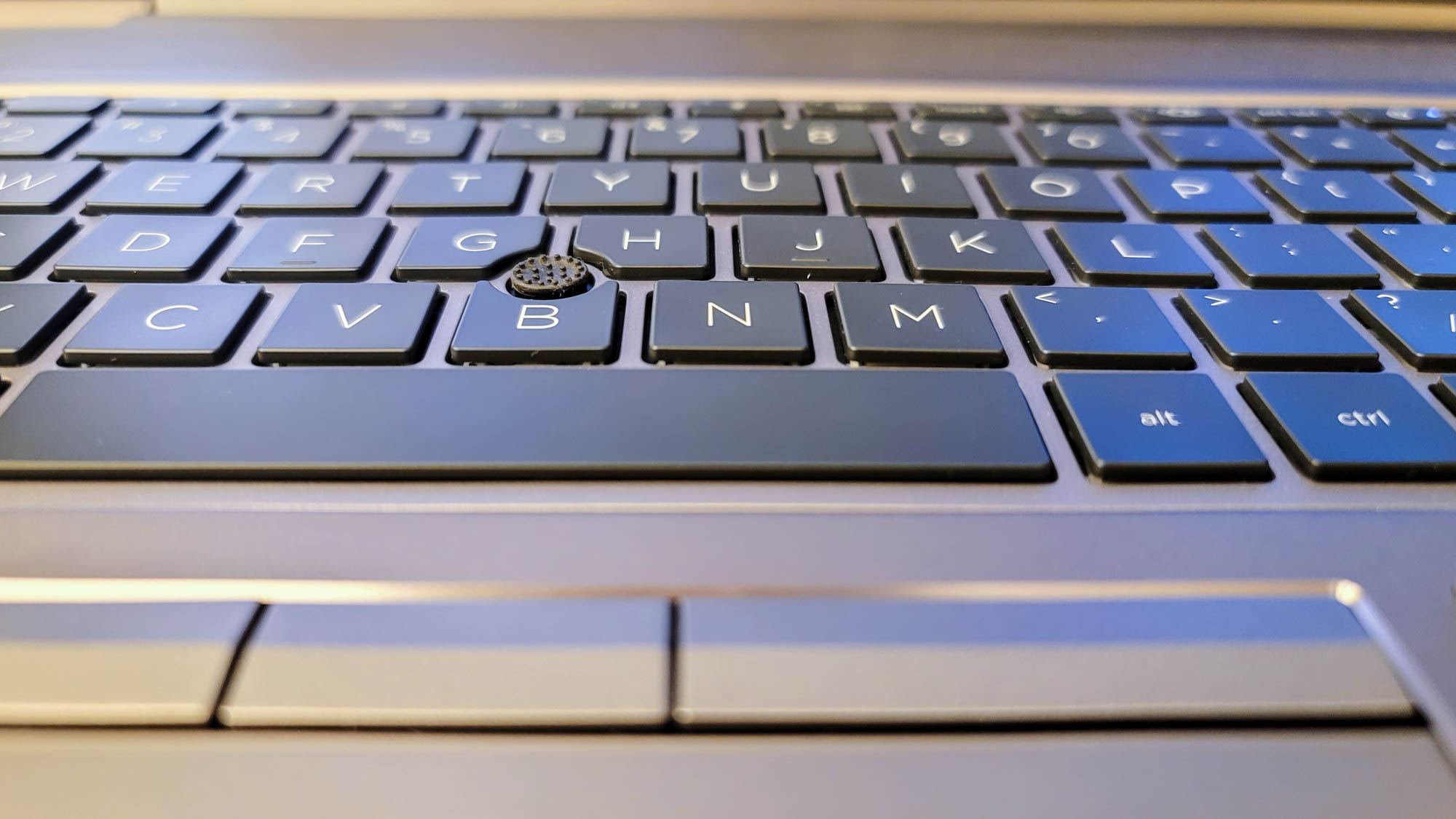
On the far right side of the keyboard deck, you’ll find a fingerprint reader and Intel Xeon logo, which is the only foreshadowing you’ll find of the mind-melting power inside.
Measuring 15.7 x 10.5 x 1.1 inches and weighing 7 pounds flat (according to my home scale), the ZBook Fury 17 G8 sure isn’t pulling any punches when it comes to beefiness. This is noticeably larger and heavier than the MSI WS66 10TMT (14.2 x 9.7 x 0.7 inches, 4.6 pounds), HP ZBook Studio G8 (13.9 x 9.2 x 0.7 inches; 3.3 pounds), and Asus ProArt StudioBook 15 (14.2 x 9.9 x 0.7 inches, 4.4 pounds).
Underneath, roughly one-third of the chassis is dedicated to airflow; make sure there’s plenty of clearance around that giant vent. I did most of my testing with the ZBook Fury 17 G8 perched on top of my laptop stand, which has a built-in USB-powered fan to help calm the beast within.
Worthy of note: the keyboard is treated with a Duracoat layer to make cleaning easier, and the screen is tested to withstand 1,000 “routine cleanings with select household wipes.” Laptop keyboards can become a cesspool of bacteria in a hurry, so it’s nice to see HP keeping cleanliness top-of-mind...err, hand.
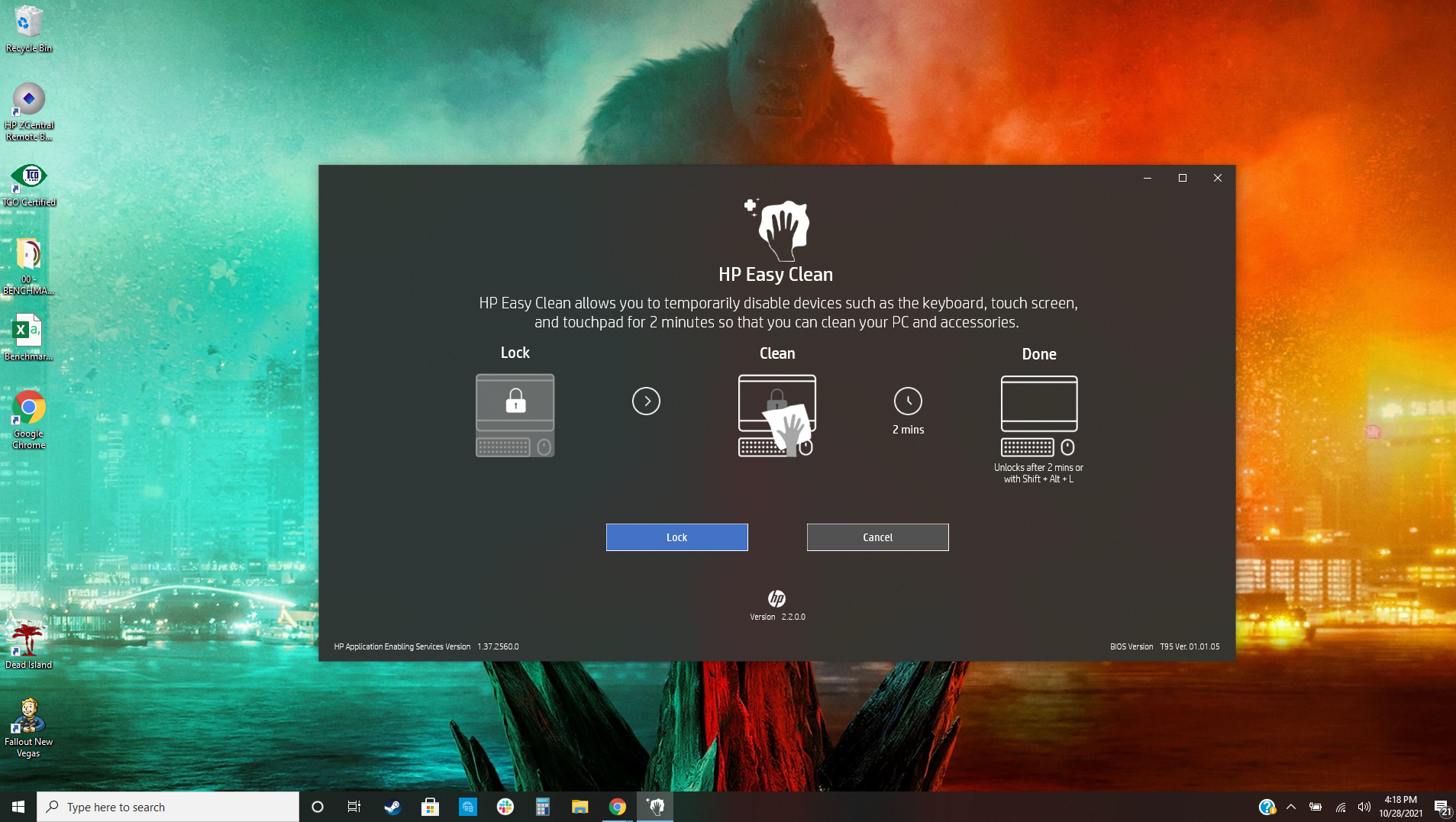
HP ZBook Fury 17 G8 mobile workstation: Ports
Speaking of port support, the laptop’s left side sports an RJ-45 Ethernet port, a security cable slot, three SuperSpeed USB Type-A ports, a headphone jack, and a smart card reader.
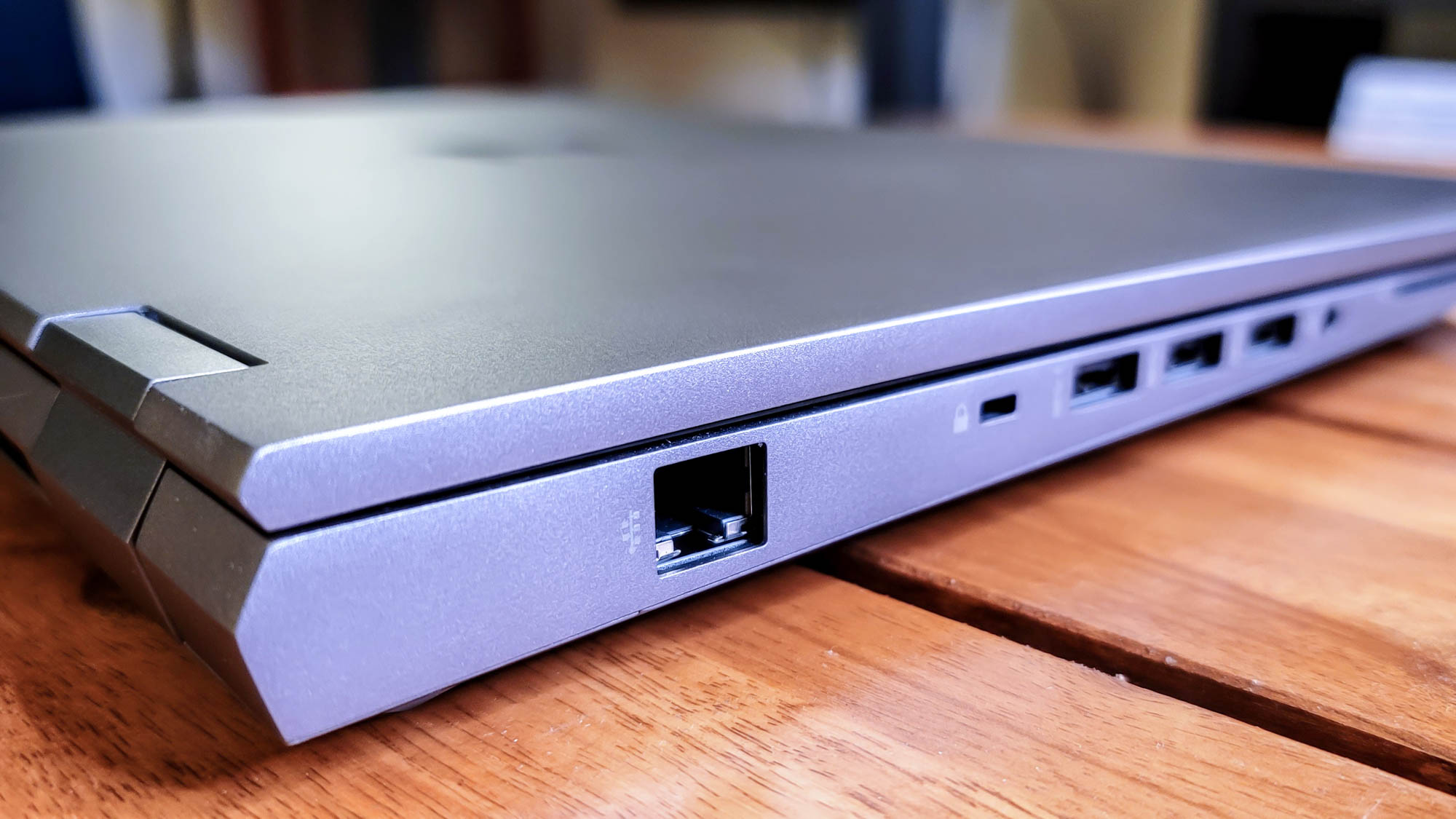
On the right, HP packs in a power connector, two Thunderbolt 4 ports, a DisplayPort connector, an HDMI port, and an SD card slot. In short, if high-speed connectivity is important for your day-to-day, you won’t need an external docking station to achieve it on the ZBook Fury.
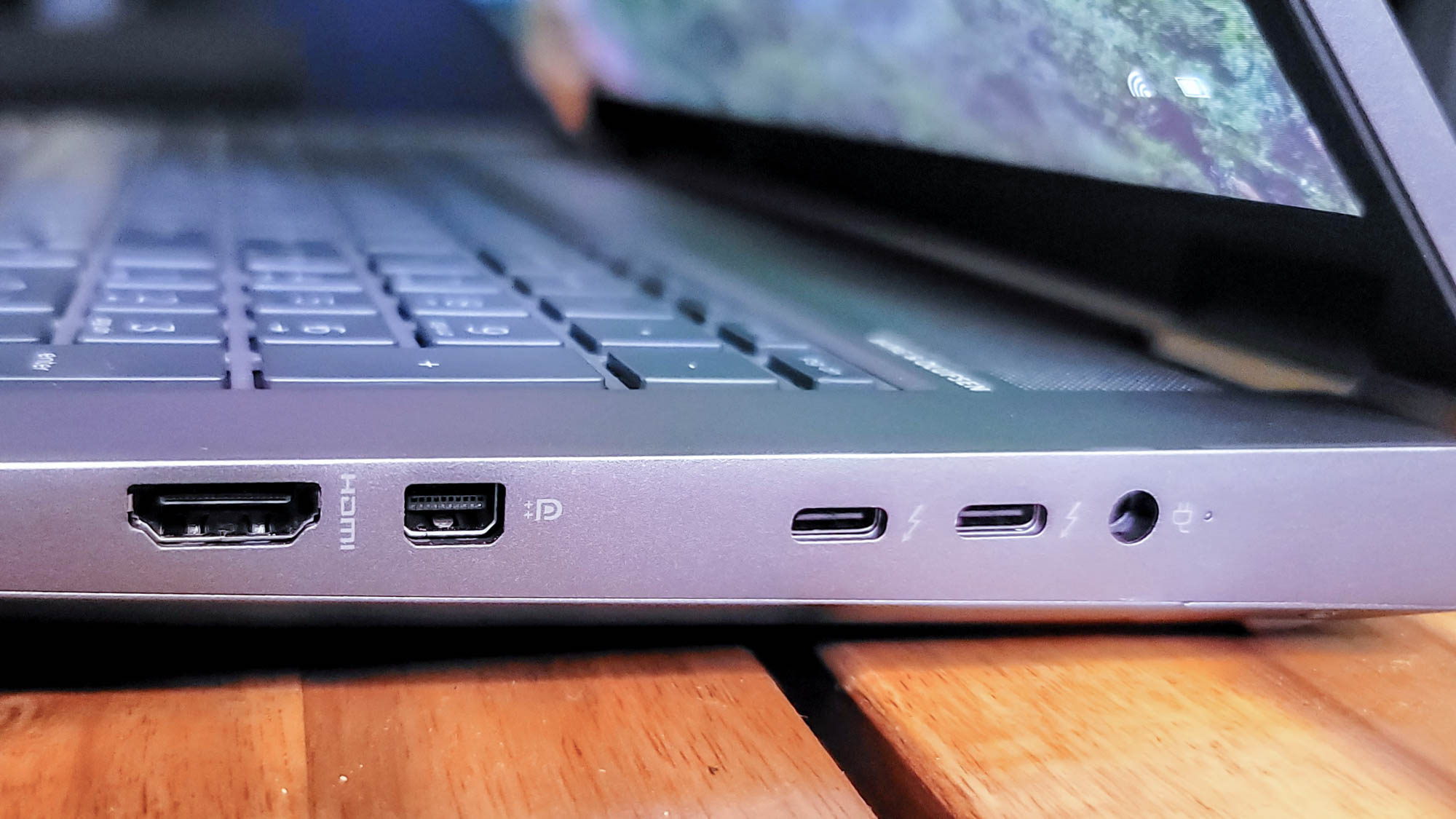
I’ve got zero complaints in the connectivity department, and the ZBook Fury 17 G8 has a better selection than the MSI WS66 10MT. For example, when it comes to USB Type-A and Type-C ports, the latter laptop only has one of each.
HP ZBook Fury 17 G8 mobile workstation: Security and durability
If you’re going to drop a sedan-sized amount of coin on your next laptop, you’d expect at least a few safeguards to protect your investment. Don’t worry, similar to the HP ZBook Studio G8, the ZBook Fury 17 G8 is loaded with lucrative layers of protection from the inside out, starting with an embedded TPM 2.0 chip and HP’s BIOSphere Gen 6 enhanced firmware protection. Master boot record security keeps your hard drive safe with each and every shutdown; HP Sure Click opens suspicious websites from a micro virtual machine to keep potentially malicious files separate from your system; Windows Defender offers antivirus and malware protection. With Tamper Lock, you can get a notification if anyone tries to open the laptop for any reason.
The aforementioned lock slot on the laptop’s left side lets you tether the ZBook Fury 17 G8 to a nearby desk (or intern). But hey, this behemoth is sure to inspire envy from local onlookers, so if anyone gets sticky fingers, the ZBook’s new Tile integration allows you to locate your laptop from afar (ie, your phone), even if it’s been powered off.
But that’s not all. When it comes to sign-in options, you’ve got six to choose from:
Face — The webcam scans your mug and signs you in, easy-peasy. In my testing, this feature worked flawlessly.
Fingerprint — You can also keep wandering eyes from your work with the integrated fingerprint reader, which only takes a few seconds to set up. (This is my preferred method of signing in.)
PIN — Sign in with a four-digit PIN.
Password — Use a boring ol’ password to sign in, like my Great Uncle Stu.
Picture Password — For any (other) giant children out there, you can use your favorite photo to unlock the device. Rad.
Any workstation should be equipped to handle the occasional drop, and it’s nice to know the ZBook Fury 17 G8’s keyboard is spill-resistant; HP ran this thing through 120,000 hours of total scrutinization, which sounds fairly thorough in my (Z)book. Plus, the whole thing is tested to MIL-STD 810G standards for drops, shocks, vibration, and humidity. I don’t care what my paperwork says, though. There’s no way I’m deliberately dropping a 7-pound, $6K machine onto my hardwood floor. I just can’t do it.
HP ZBook Fury 17 G8 mobile workstation: Display
OK, let’s get to the good stuff. This workstation was designed specifically to handle multimedia, so as you might surmise, the 17.3-inch UHD (3840 x 2160) BrightView LED touchscreen display (60 Hz) is pretty damn stunning to behold. It’s a fancy feast for the eyes, to be sure, especially since mine are used to the 1920 x 1080-pixel resolution of my accompanying 27-inch Samsung LC27F398FWNXZA curved monitor. From high-res YouTube videos to full-res nature photos, the finer details of 4K that are typically lost on lesser displays came through with aplomb on the ZBook Fury.
Fun fact: HP has been collaborating with DreamWorks for years to create more colorful, visually appealing displays with DreamColor; they even shared an Academy Award with DreamWorks in 2015 for their efforts in developing the technology.
To put the display through its pixel-y paces, I used the ZBook Fury 17 G8 to edit some 4K photos, watch a variety of hi-res videos on YouTube, and compare the image quality with my 1080p Samsung display. As I browsed aerial time-lapse footage of Norway, every fiery sunset or ghostly Northern Lights shot came through beautifully, with crisp, accurate colors throughout as the camera panned from one picturesque landscape to the next. That’s not to say my Samsung monitor is subpar, but in a side-by-side comparison, colors popped on HP’s DreamColor monitor by a noticeable margin.
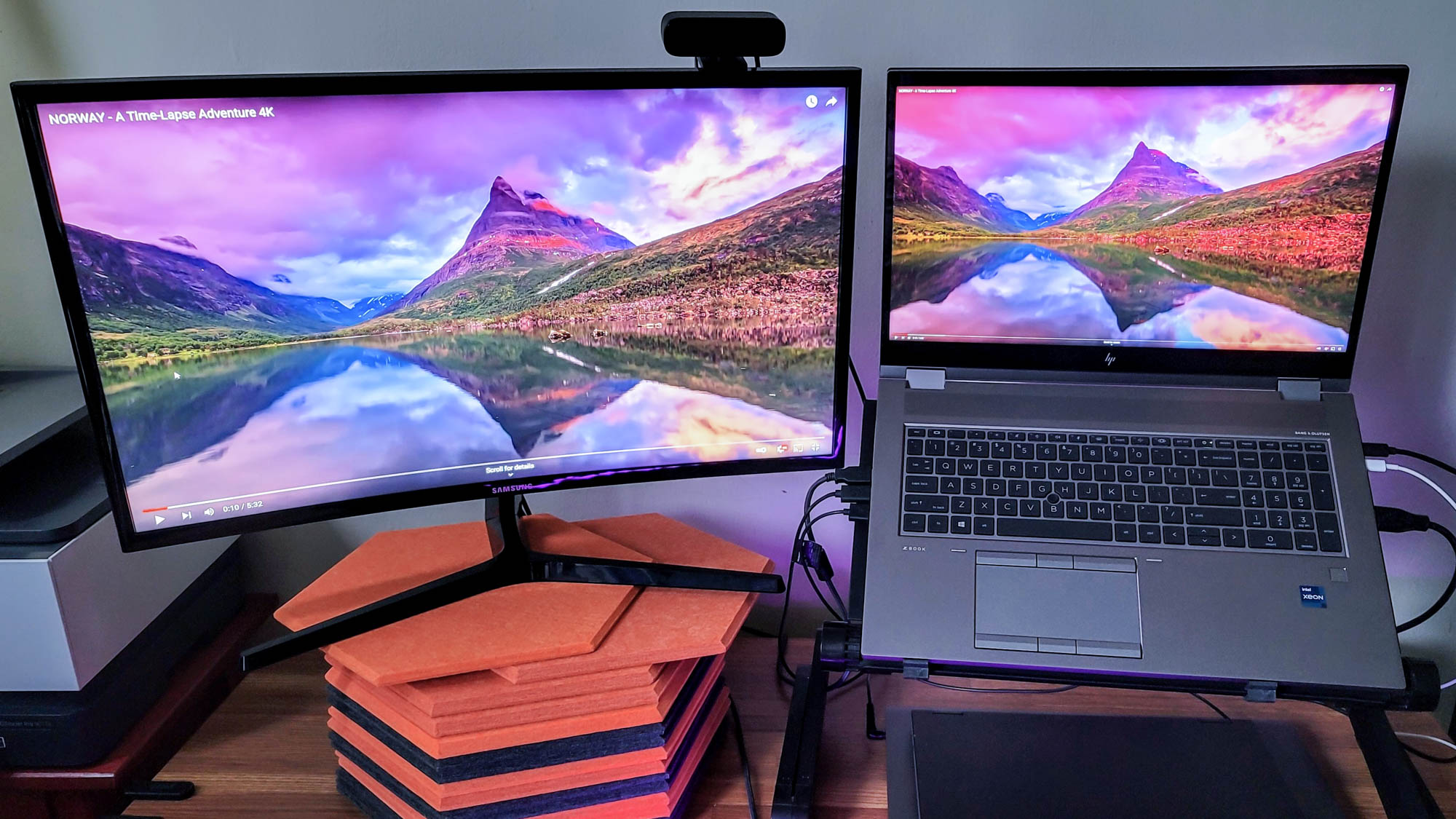
To further examine what this DreamColor display has to offer, I downloaded a 4K Godzilla wallpaper to my desktop. The Zbook Fury did a fantastic job of portraying every minuscule detail — down to the last reptilian pore on Godzilla’s grimacing mug; you can tell at a glance that he’s charging up his atomic breath, and it’s easy to make out the meticulous shadow work that went into this particular rendering.
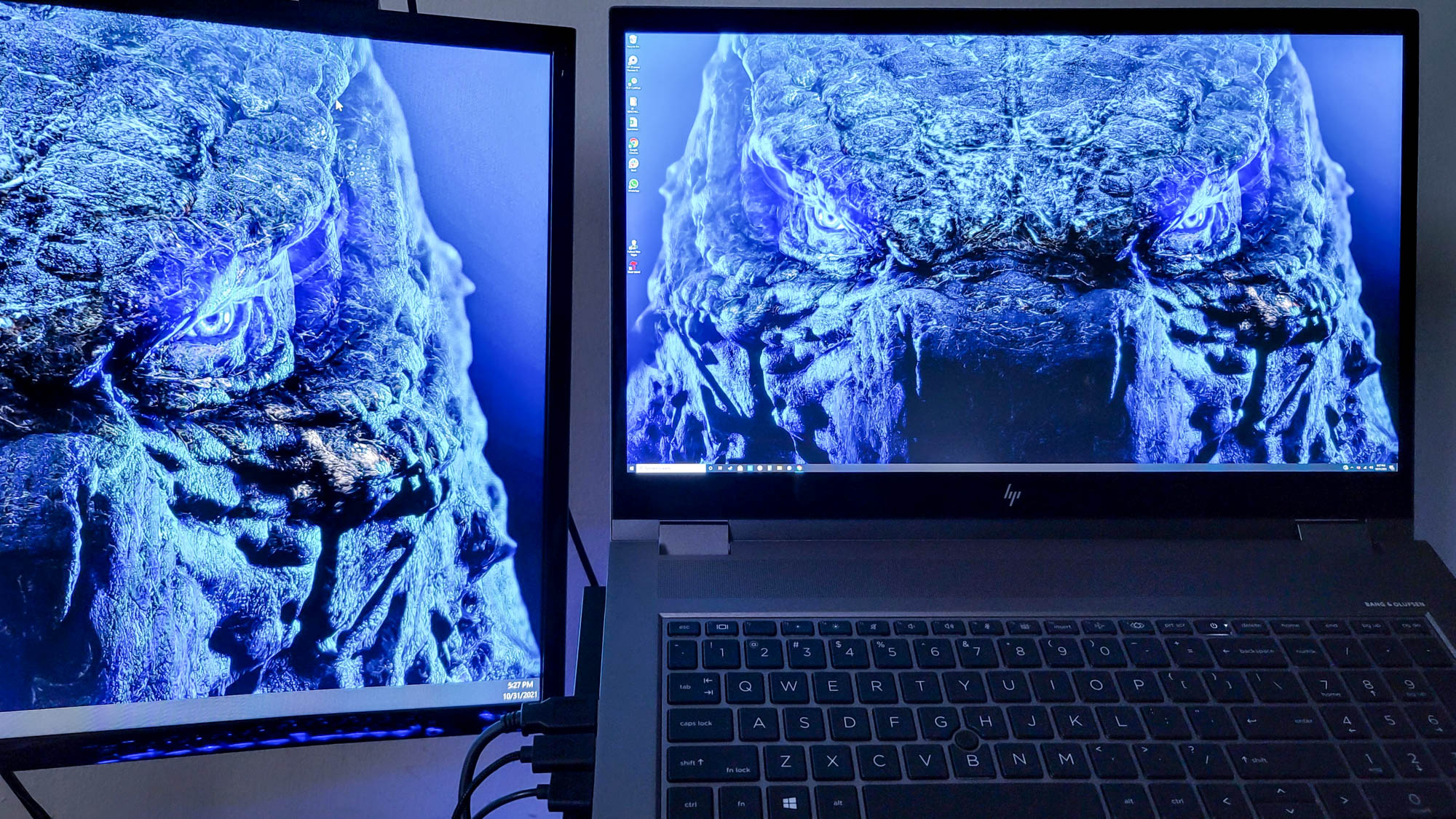
We measured the ZBook Fury’s display with a colorimeter and boy, oh boy did it deliver with an outstanding 161.7% of the DCI-P3 color gamut, whizzing past the premium laptop average of 84.4%. This is much higher than the ZBook Studio G8 (142.5%) and MSI WS66 10TMT (78%), yet slightly lower than Asus ProArt StudioBook 15 (171%).
For our brightness test, the ZBook Fury 17 G8 scored an average brightness of 532 nits, which is substantially higher than the ZBook Studio G8 (464 nits), and worlds ahead of the MSI WS66 10TMT (346 nits).
HP ZBook Fury 17 G8 mobile workstation: Keyboard and touchpad
I don’t have any issues with the keyboard, which is pleasantly comfortable to type on; there’s also plenty of room to rest your wrists on either side of the trackpad as you work. The Chiclet-style keys are clicky and responsive, with excellent key size and travel.
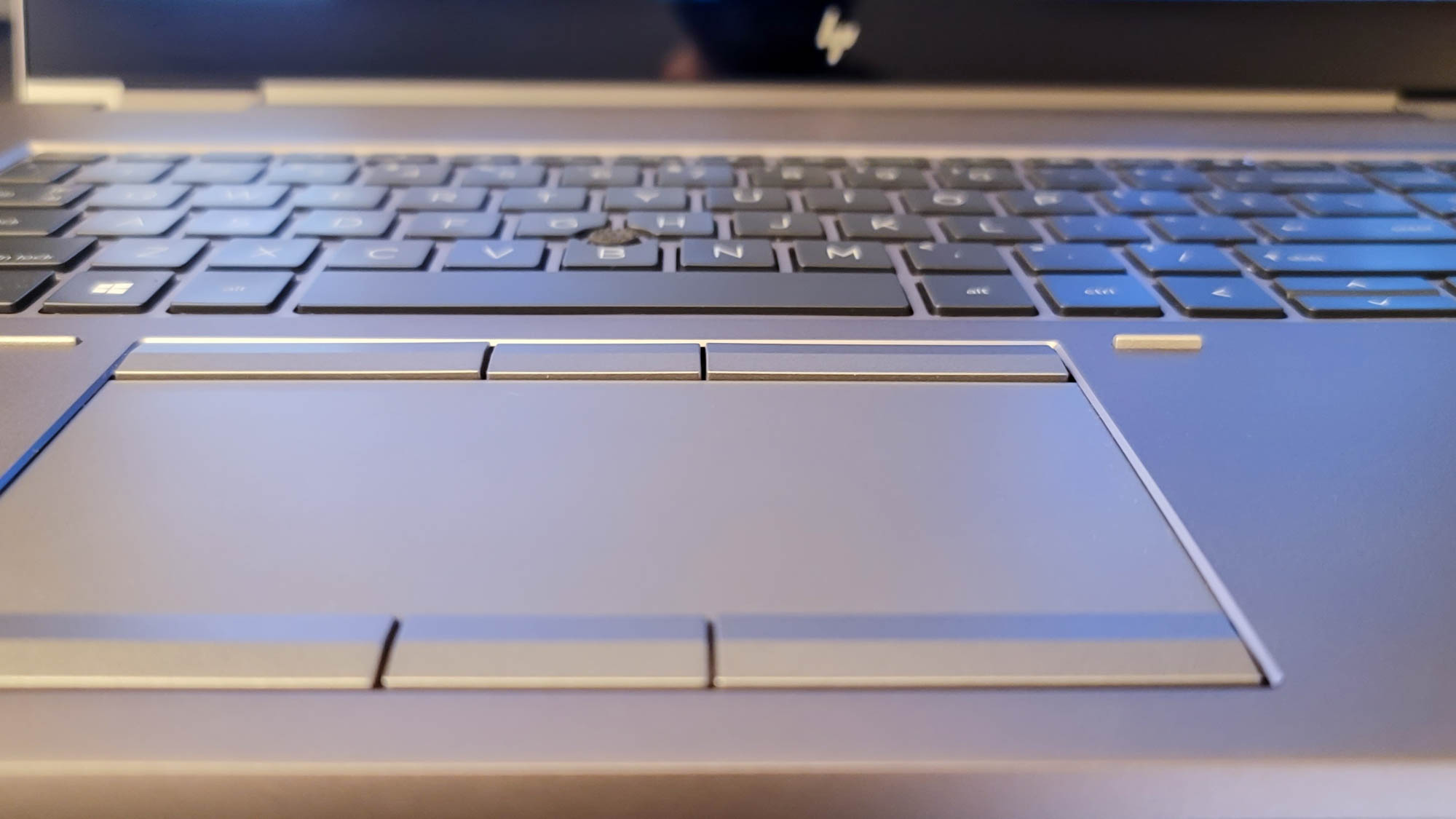
I use a mechanical gaming keyboard for most of my writing, but it was easy to acclimate to the ZBook Fury 17 G8’s keyboard deck as I used it for various admin chores. During the 10FastFingers.com typing test, I achieved a speed of 70 words per minute with the former (94% accuracy), and 67 words per minute with the latter (93% accuracy).
The large 5 x 2.4-inch touchpad sits slightly left of center below the keyboard, and it feels silky smooth when navigating web pages with multi-touch gestures and finger swipes. As I wrote this review, it was also useful to have the pointstick right by my pointer finger, so I could type and toggle between windows on multiple monitors without lifting my hands from the keyboard deck.
HP ZBook Fury 17 G8 mobile workstation: Audio
Most laptops don’t have much to offer in terms of audio prowess — for purely logistical reasons. Once you’ve crammed all the other hardware inside the ZBook Fury’s (already massive) chassis, there’s not much room left for a quality sound system. Nevertheless, HP does their damndest with top-firing dual stereo Bang & Olufsen speakers, positioned just above the keyboard.
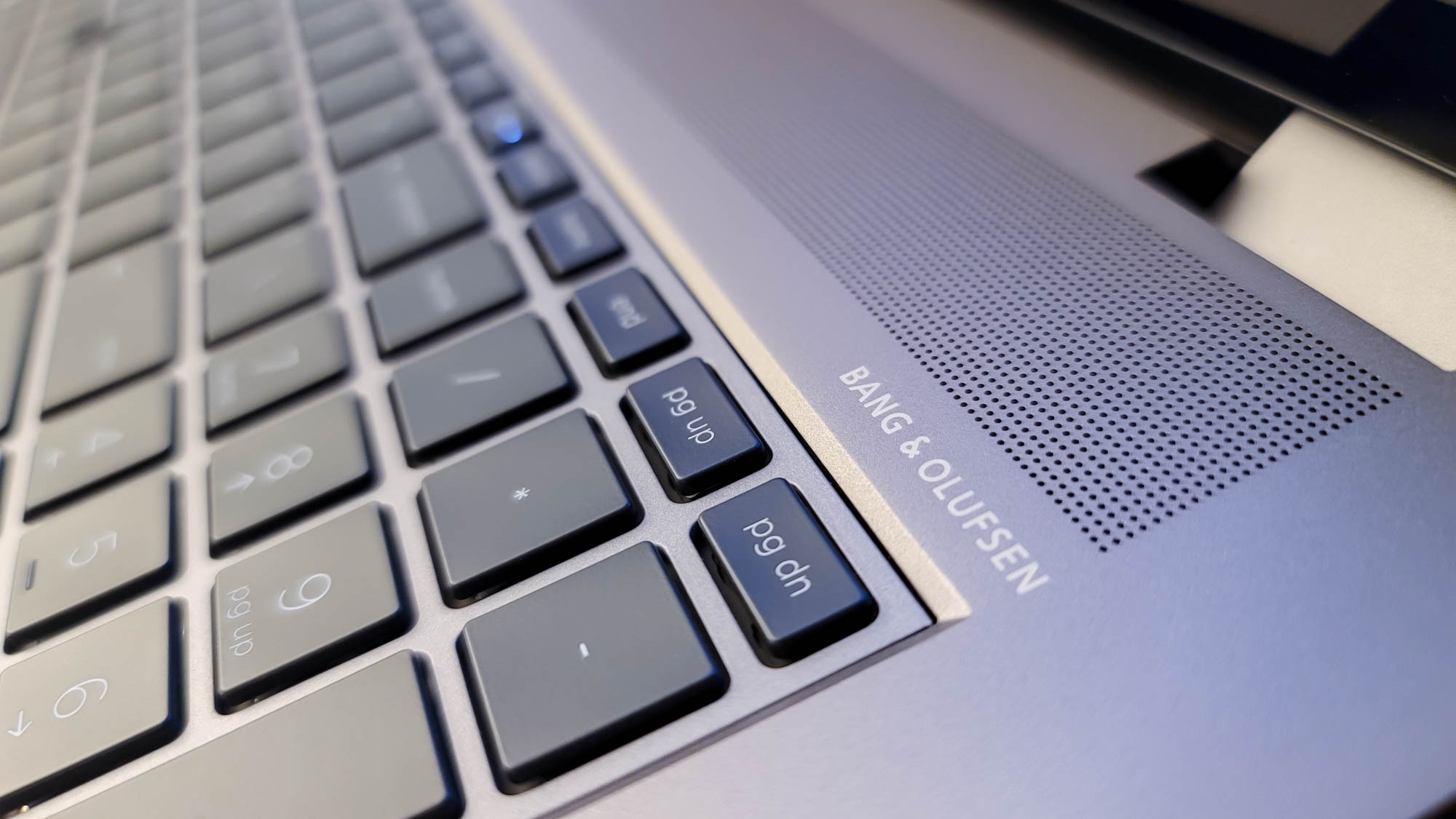
When I turned up “Everybody Breaks” by Ivan & Alyosha at max volume, the introductory vocals were tinny at best, and muddy at worst; once the instrumentals kicked in, I was predictably disappointed with the lack of overall sonic depth. Luckily, HP’s Audio Control has a 10-band equalizer. The Pop, Rock, and Bass presets resulted in much more balanced audio as I toggled between them.
If you’re serious about audio quality, you’ll want to invest in a good set of computer speakers for your down time, and a pair of noise-cancelling headphones for your privacy time.
HP ZBook Fury 17 G8 mobile workstation: Performance
Hybrid work scenarios are here to stay, and as we collectively transition our tech into more eclectic careers, it’s becoming more and more important for mobile professionals to have the most capable workstations at their fingertips. From lightweight Zoom meetings to MS Office chores to heavy duty data crunching, 3D imaging, video editing, and much more, the demands of our laptops are rapidly evolving, and the Fury 17 G8 isn’t messing around when it comes to future-proof functionality.
Enter the one-two punch of Intel’s latest Xeon processor and Nvidia’s RTX A5000 graphics platform, paired with a massive 64GB of RAM (plus 16GB of GDDR6 dedicated VRAM) and you better believe that this thing can handle anything you throw at. With 50 Google Chrome tabs open (10 playing 4K YouTube videos); music streaming over Spotify; and the laptop connected to two external displays in addition to my 4K smart TV, the ZBook Fury 17 G8 didn’t bat an eye, no matter how intense my multitasking became.
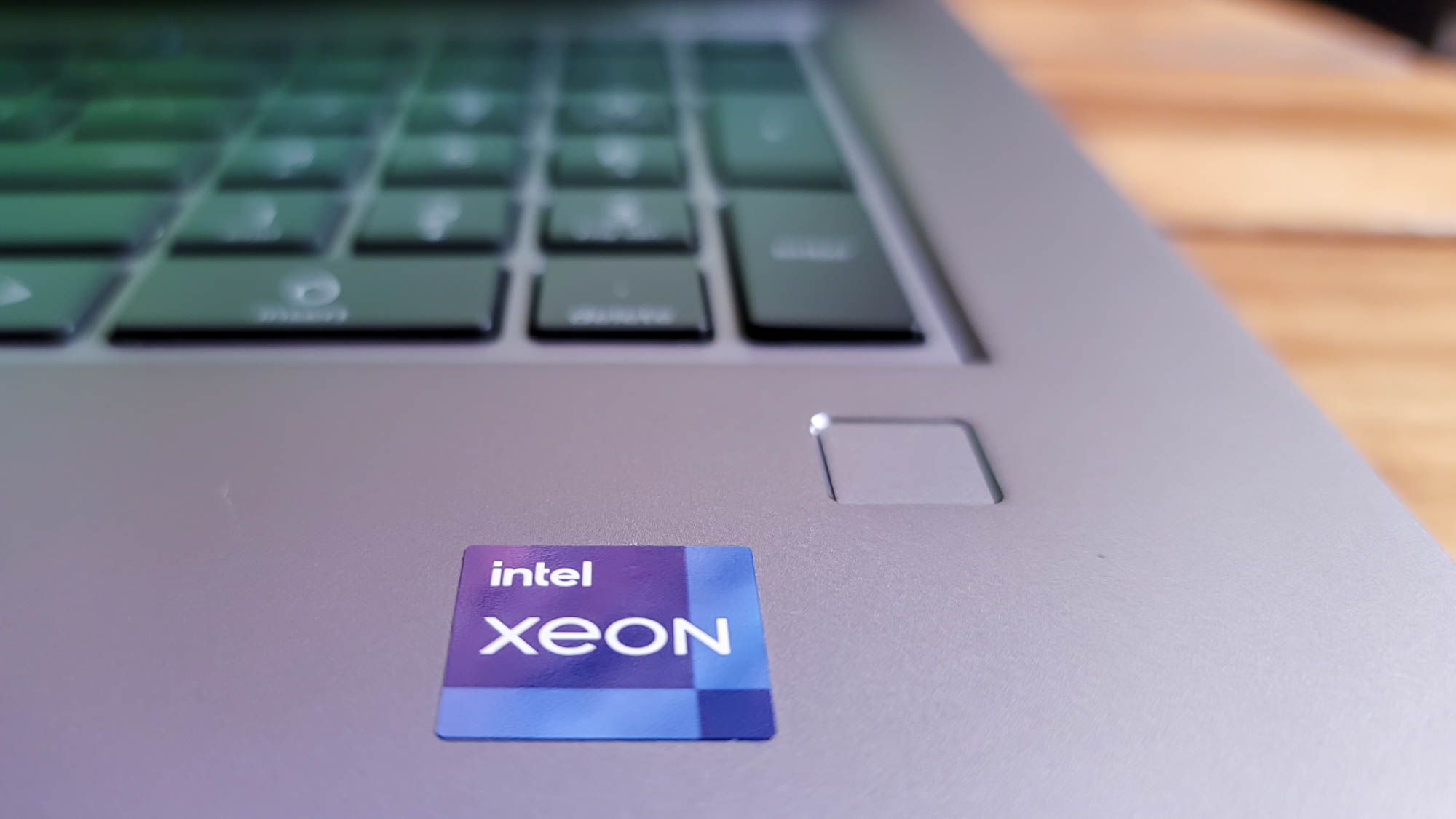
But if you really want to see what makes the ZBook Fury stand out among other top-tier workstations, look no further than our comprehensive collection of benchmark scores. Clocking in at 9,716 on our Geekbench 5.4 overall performance test, the ZBook Fury 17 G8 blew the premium laptop average of 4,753 clear out of the water, along with its closest competitors. The Intel Core i9-powered ZBook Studio G8 is nipping at its heels with 9,034, followed by the Dell XPS 15 (7,477), MSI Creator Z16 (7,335), and ZenBook Pro Duo 15 (7,028).
On the Handbrake video transcoding test, it took 6 minutes and 27 seconds to convert our 4K video to 1080p, easily surpassing the category average (14:47) and edging out the ZBook Studio G8 by a hair (6:33).
The ZBook Fury 17 G8 also excelled in our file-transfer test, duplicating a 25GB multimedia file in 23.2 seconds at a rate of 1,155 megabytes per second, far quicker than the category average of 1:24. This is on par with the ZBook Studio G8 (1,175.8 MBps) and Dell XPS 15 (825.6 MBps), but not quite as speedy as the MSI Creator Z16 (1,635.5 MBps)
In more real-world scenarios, the ZBook Fury 17 G8 achieved a score of 931 in our Lightroom Classic benchmark — more than double the category average of 422, and well ahead of the MSI WS66 10TMT (846). The Photoshop test score of 1,017 is also well above average (613). In Premiere Pro, it earned a benchmark score of 653, which handily beats both the WS66 and the category average.
HP ZBook Fury 17 G8 mobile workstation: Graphics
Whether you need it for work or play, the ZBook Fury 17 G8 excels when it comes to high-res gaming and graphics-intensive programs thanks to the Nvidia RTX A5000 GPU and 16GB of VRAM. Of course, it’s kind of tricky to demonstrate how powerful this machine really is with your typical multimedia software, which is where our other benchmarks come in.
With a 3DMark Fire Strike score of *ahem* 20,444, you know this machine ain’t messing around. Heck, the category average here is just 4,351. This is light years ahead of the MSI WS66 (16,788, Quadro RTX 5000 Max-Q), ZBook Studio x360 G5 (4,451, Quadro P1000), ProArt StudioBook 15 (13,767, GeForce 2060), and WS65 (15,364, Quadro RTX 5000).
We also tested out the GPU with Sid Meier’s Civilization VI: Gathering Storm (1080p) benchmark. The ZBook Fury handily managed 83.7 fps in 1080p and 69.7 fps in 4K, which outpaces the category average of 32 fps by a long shot. Still, this remains a hair behind the mighty MSI Creator Z16’s 95.5 fps score in 1080p.
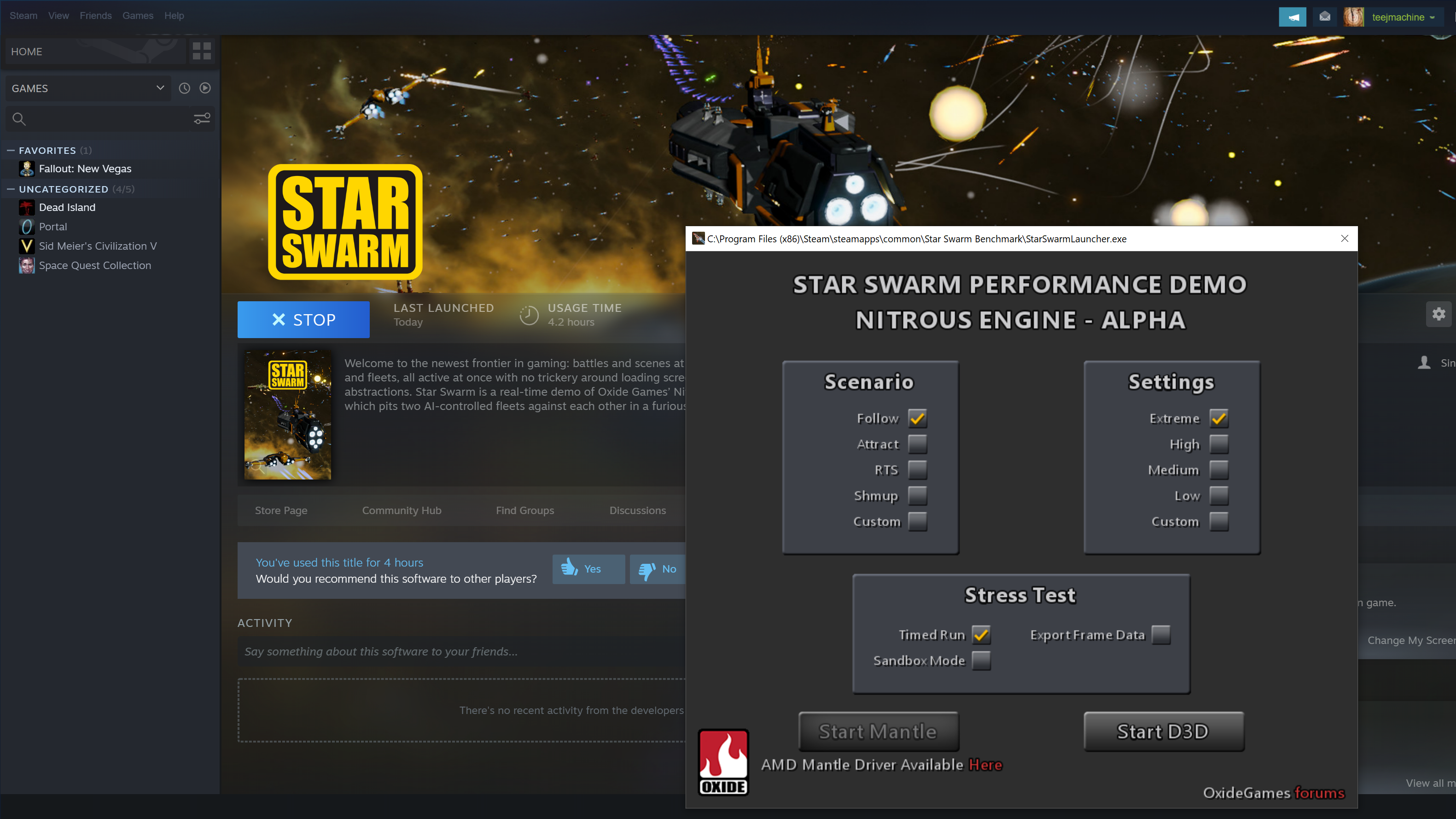
As a final real-world test of the ZBook Fury 17 G8’s graphics prowess, I fired up Steam and ran the Star Swarm benchmark, which pits two AI-powered space fleets against each other in an attempt to stress your system out to the max. For comparison, I ran the same benchmark on the 17-inch LG Gram (2020), which has a 1.6-GHz Core i7-1065G7 CPU and integrated Intel Iris Plus Graphics. Whereas the underpowered LG Gram only managed an embarrassing average of just 6.3 fps, the ZBook Fury didn’t even break a sweat as the intergalactic battle started heating up, maxing out at 101.3 fps. During the most frenetic points in the firefight, there was barely a hint of lag. Wowsers!
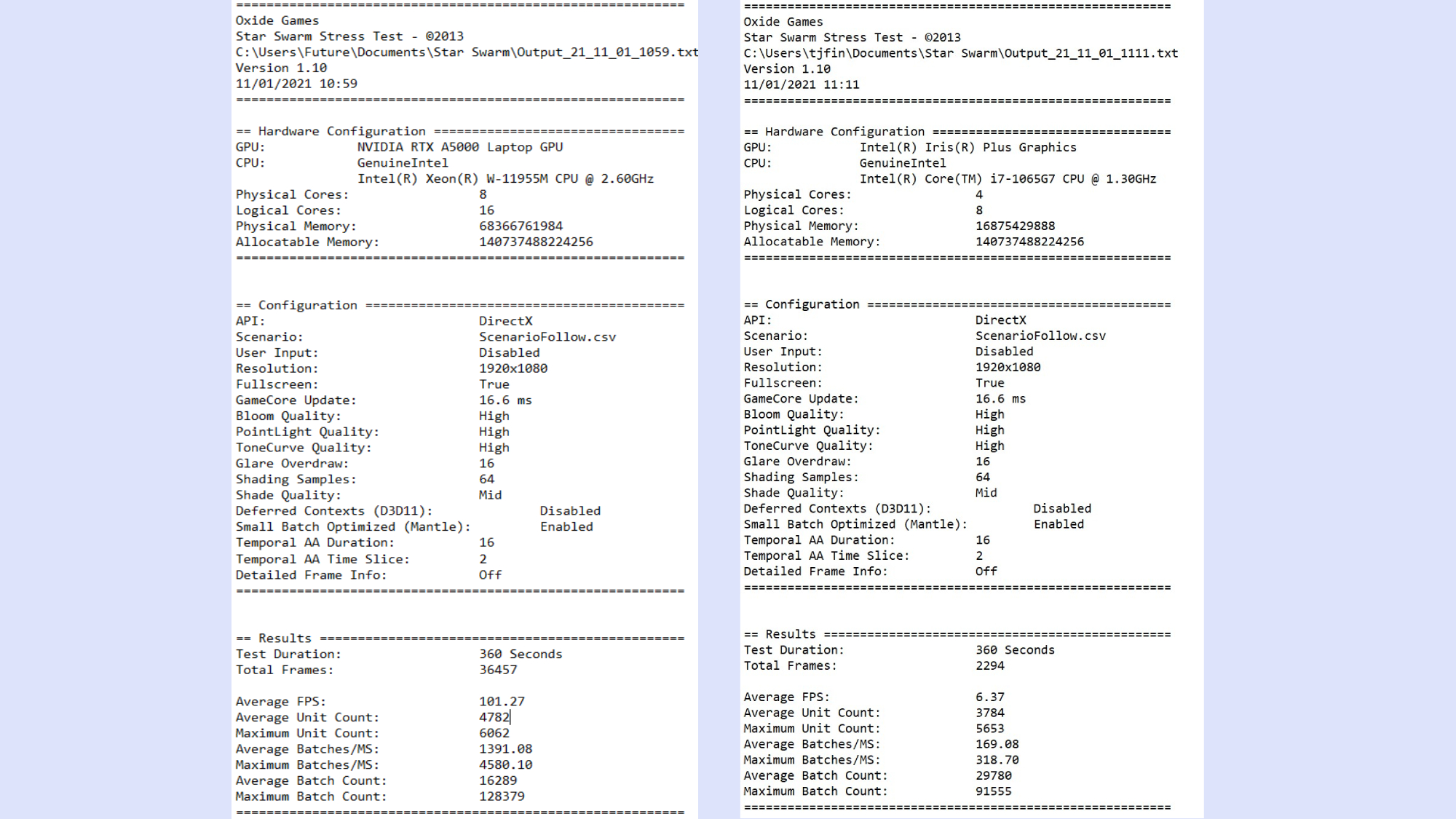
Note: this system is perfect for the HP Reverb G2, which we’ll be testing soon. Stay tuned.
HP ZBook Fury 17 G8 mobile workstation: Battery life
Don’t stray too far from your nearest power source, my friends.
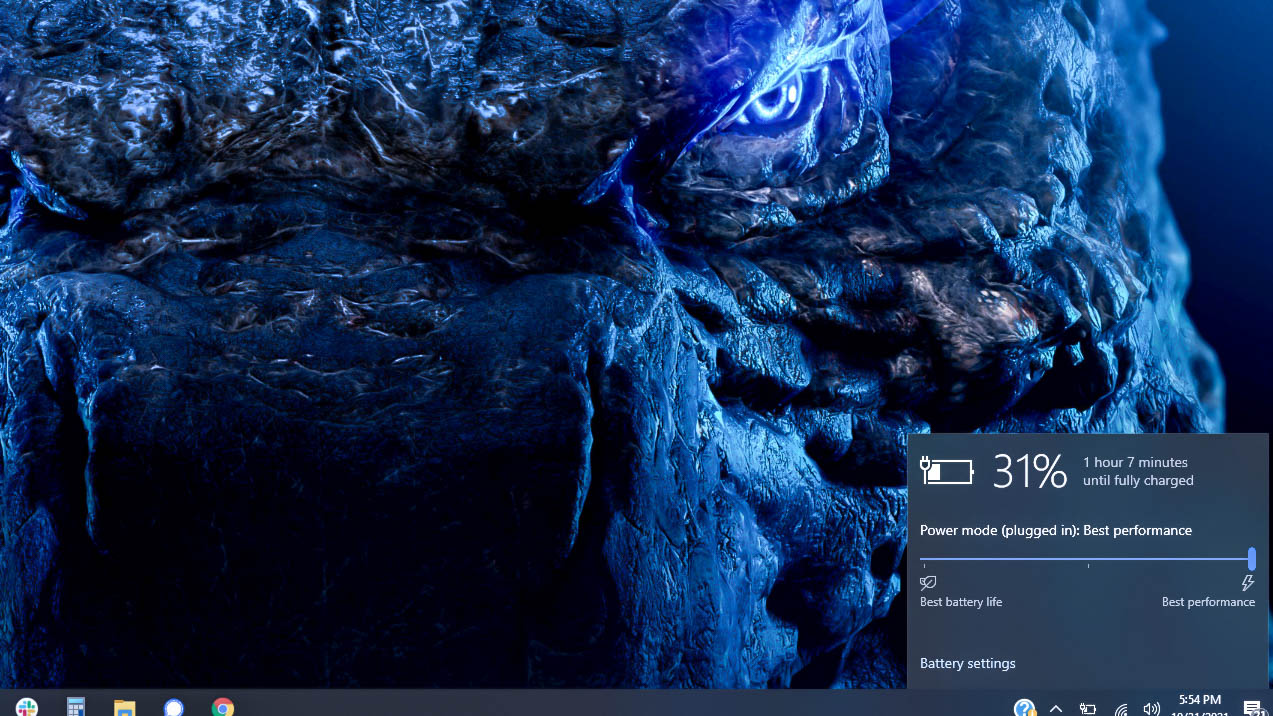
During the Laptop Mag battery test, which involves continuous web surfing over Wi-Fi at 150 nits of brightness, the ZBook Fury 17 G8 lasted 7 hours and 10 minutes, which is far more palatable than 2 hours, yet still a far cry from the premium laptop average (10:23). Nevertheless, it’s better endurance than the ZBook Studio G8 (4:23) and ProArt StudioBook 15 (3:39); if you’re looking for more juice, the Zbook Studio 360 G5 (9:06) and MSI WS66 10TMT (10:10) are worth checking out.
HP ZBook Fury 17 G8 mobile workstation: Webcam
It kind of boggles my mind how laptop manufacturers can put so much impetus on their internal specs, and then skimp out completely with the built-in optics. Such is the case with the ZBook Fury 17 G8’s 0.9-megapixel 720p webcam, which produces decently accurate skin tones in good lighting over Zoom, but every image is loaded with extraneous visual noise.
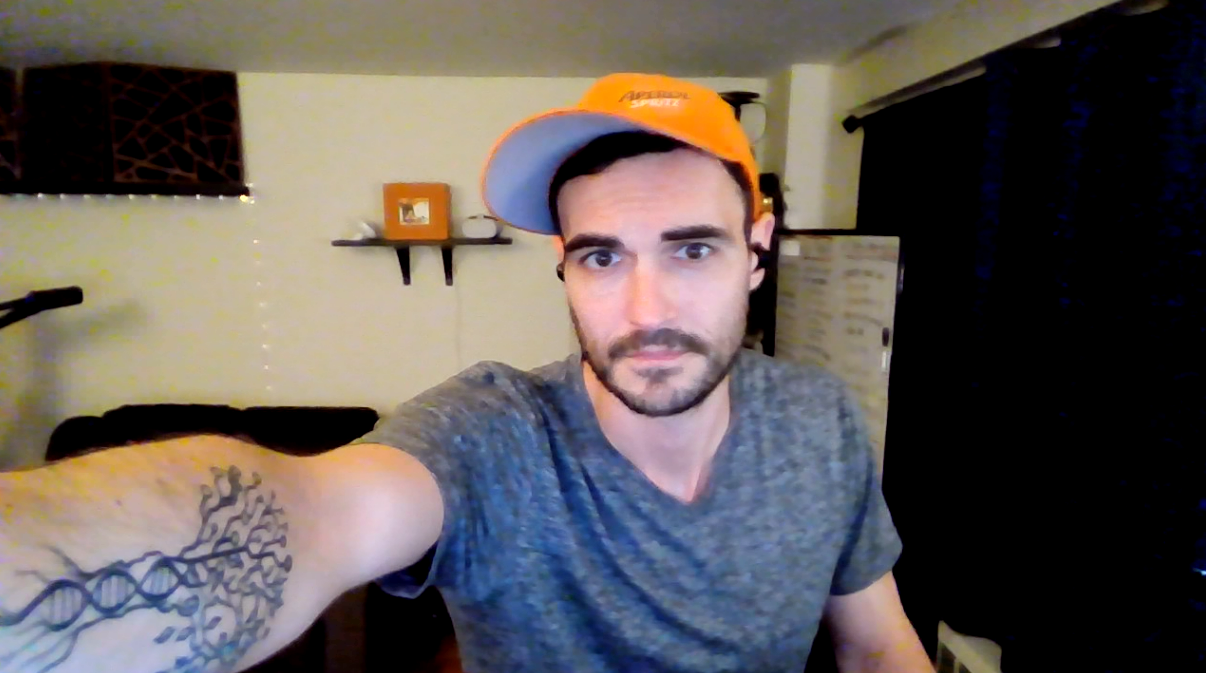
For comparison, I plugged in my Anker PowerConf C300 1080p webcam, and the difference in photo/video quality was night-and-day; the finer details of my beard and forearm tattoo were actually visible in frame, as opposed to the blurry shots taken from the laptop itself. Trust me: if you spend a lot of time on video calls, you’ll want to invest in one of the best external webcams for the purpose.

HP ZBook Fury 17 G8 mobile workstation: Heat
Let me put it this way: if you plan on purchasing the ZBook Fury 17 G8 for your Icelandic wildlife observation facility, you’re in luck. This thing can practically double as a heat source for your ice fishing hole; after playing a 1080p video on loop, the underside reached a scorching 111 degrees Fahrenheit at its hottest point, which is noticeably hotter than our 95-degree threshold of general crotch comfort.
Thankfully, the topside runs much cooler, with the touchpad and keyboard only reaching 76 and 87 degrees, respectively.
HP ZBook Fury 17 G8 mobile workstation: Software and warranty
If bloatware gets on your nerves, don’t worry, HP doesn’t go overboard in this department. The Windows 10 OS is complemented by such useful extras as HP Client Security Manager, HP Sure Click Secure Browser, and HP Quick Drop, which makes it easy to transfer files between your phone and laptop.
The ZBook Fury 17 G8 comes with standard Windows 10 bloatware, including Skype, the Xbox Game bar, and Microsoft’s anti-popular Edge browser.
The HP ZBook Studio G8 comes with a three-year limited warranty. See how HP stacked up in our annual Tech Support Showdown and Best and Worst Brands.
Bottom line
If Tim “the Toolman” Taylor owned a laptop, it would be the HP ZBook Fury 17 G8. Heck, this workstation has just the sort of specs to make him grunt in approval. In terms of raw power, this notebook is tough to beat, and even if it runs out of battery when you’re on the go, it’s still heavy enough to fight crime with.
Granted, the $6K configuration we tested is overkill for most laptop users; it’s nigh impossible for this kind of mobile muscle to fail too hard on our standard benchmarks. And that’s partially the point, in my opinion. The world of mobile tech continues to march forward at an exponential rate, and if you don’t have the right laptop for your respective career, opportunity might very well pass you by. But that’s hardly a concern with the ZBook Fury 17 G8 thanks to a stunning 17.3-inch touchscreen, intimidating specs under the hood, and plenty of ports to power your pertinent peripherals.

As a freelance journalist, TJ has over a decade of multi-medium storytelling under his belt. Leveraging a quarter century of collective coddiwompling amid the ever-evolving landscape of wireless gadgetry, his unique editorial background allows him to explore a variety of tech-centric subsectors on this fascinating planet. When he's not field testing new gear in the Catskills, Adirondacks, or an actual field, he can be found sipping Negronis in his living room and crafting Dr. Seussian poetry inside a tattered moleskin.
